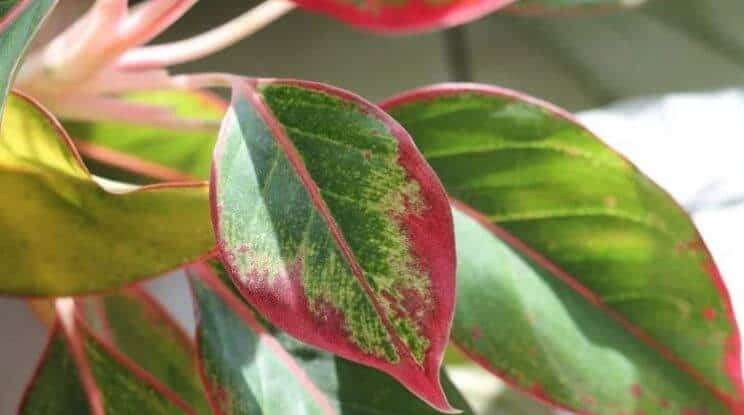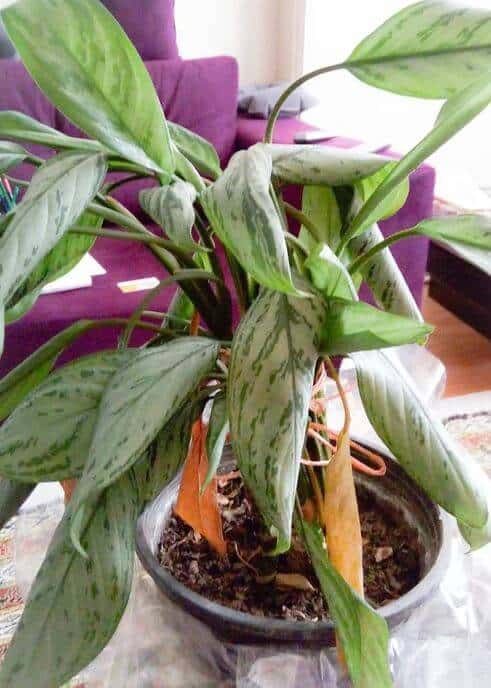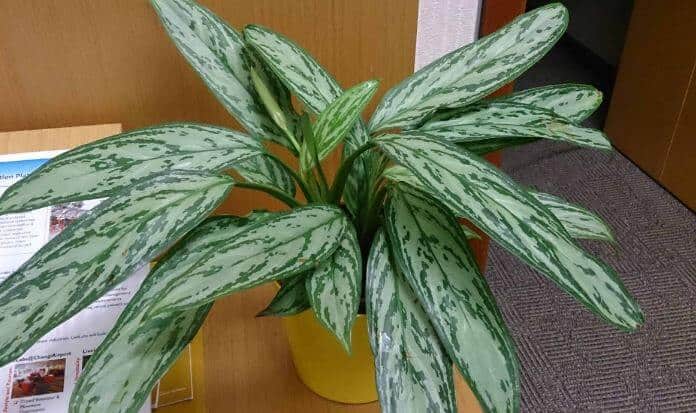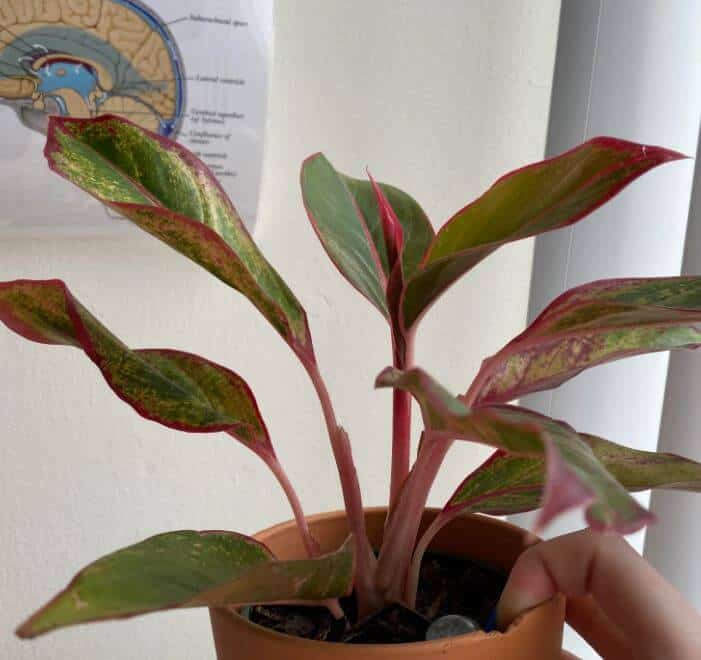Last Updated on February 13, 2023 by a Friendly Gardener
Popularly known as the Chinese Evergreen, the Aglaonema are lovely houseplants that are especially appreciated for their show-stopping foliage. The Aglaonema is a hardy indoor plant that is very easy to care for. Sometimes, however, leaves will curl. There are a variety of reasons for curling foliage and what you need to do to fix a curling habit.
The aglaonema is a native of Asia featuring short stems with long somewhat narrow foliage. Leaves have beautiful veining conferring a unique design to leaves. Aglaonema varieties include shades of silver, dark green, and even red.
It’s important to identify the underlying cause for your plant’s behavior by searching for specific symptoms that will also indicate how to intervene to get your plant healthy and happy once more.
Why Are My Chinese Evergreen Leaves Curling?

The Chinese Evergreen is a terrific choice for beginner indoor gardeners. It boasts an attractive appearance, moderate growth, and is quite hardy which helps when you are starting an indoor houseplant collection. It also is a wonderful option for homes or offices that have low-light environments. If your location doesn’t have lots of large windows or windows are partially blocked or shaded, this is a plant that you’ll want to consider.
Chinese Evergreen curling leaves can be caused by one of several reasons and the leaves may cease curling and return to a straighter position once the cause is identified and resolved. Should some of the leaves not uncurl new growth will be straight.
Environmental problems may include watering, humidity, temperature, or light issues that might require some adjustment.
Watering Issues
When considering a problem with watering, four common problems may need your intervention: overwatering, underwatering, humidity, or water quality. Let’s consider each one.
Overwatering

Overwatering can be a problem for many houseplants. Aglaonema curling leaves can be a symptom of overwatering together with yellowing leaves or leaf drops. If left unattended, root rot can set in and be fatal. The Aglaonema likes a drier soil bed. Your plant requires loose, well-draining soil that has some moisture retention without becoming soggy. Roots risk drowning in waterlogged soil. Allow the top inch or so of the soil bed to dry before watering anew. It’s better not to follow a specific watering schedule, opting for touching soil to evaluate the need or not for water.
If you think overwatering is the cause, check the root system for root rot. Roots that are firm and pale in color are healthy. Mushy, dark roots that emit a foul smell are infected. The plant should be repotted, and infected roots removed. While the aglaonema does not enter dormancy, you can reduce watering during the winter.
Underwatering
If you forget to water and the soil bed dries out, leaves will curl and possibly wilt. If leaves become dry and crispy, they should be removed. Leaves that are only curling have a shot at reviving once they are watered. If the soil bed is completely dried out, you will need to bottom water by placing your plant in several inches of water in a sink or container and allowing the soil to absorb what it needs. If you wish to water from the top, do so slowly in small amounts spaced several minutes apart.
Lack of Humidity
The Aglaonemas do fine in average house humidity, but if the environmental air is too dry, foliage may begin to curl. Leaves that have not dried out will recover. Higher humidity is an advantage but not necessary. If you use central heating or air conditioning that dries out indoor air, you may want to use a space humidifier or a pebble tray to compensate.
Water Quality

While Chinese Evergreens are not overly sensitive to water quality, they can react to water containing lots of minerals or chemicals with curling foliage. You can water with filtered, distilled, or collected rainwater. If this is not possible, leave water out overnight before using so that some substances evaporate.
Temperature Issues
As tropical plants, Chinese Evergreens crave warmth and can become stressed when exposed to extreme temperatures. Aglaonema curling leaves may be accompanied by dark spotting on foliage. The Chinese Evergreen prefers indoor temperatures that measure between 70° and 80°F. Lower temps can slow growth.
Any type of chill or draft whether hot or cold can harm your plant. When temps drop to 60°F, your aglaonema is in danger.
Light Issues

Happily, for indoor gardeners, the Chinese Evergreen does well in low light conditions. The Aglaonema does well under artificial lighting. Most problematic lighting issues generally are related to too much light. Aglaonema leaves curling inward may be caused by the plant attempting to avoid sunburn scorch. Burned leaves will not recover.
The nicest thing you can do for your plant is to place it in a spot that does not receive direct sunlight.
Other Issues Known to Cause Aglaonema Leaves Curling

Excessive Feeding
The Aglaonema is not a heavy feeder. If the soil is fertile with organic material, they do not require fertilization. If the plant has been heavily fertilized there may be a problem of salt buildup in the soil which in turn can burn the roots. To contrast salt buildup, flush the soil several times and allow the plant to drain completely.
Avoid feeding during the cooler months. Dilute any fertilizer you use to one-fourth strength and only fertilize a couple of times during the growing season. When possible, use organic fertilizers as opposed to chemicals.
Inadequate Nutrition
If everything seems to be in order but your aglaonema’s leaves are still curling, consider a nutrient deficiency. Occasional fertilization can rectify this problem. One aspect to factor in, however, is the pH of your plant’s soil bed. Chinese Evergreens prefer slightly acidic soil beds. Alkaline soil can render nutrient absorption difficult for your aglaonema. Test the soil pH and amend the soil if necessary.
Pest infestations
Pest infestations can also be the cause of leaf curling as well as stunted or irregular growth. Pests most often found visiting Chinese Evergreens include aphids, mealybugs, spider mites, and scales. Check the undersides of leaves, joint attachments, and stems for evidence of bugs. Scale and mealybugs can be removed manually while mites and aphid removal might benefit from jet sprays of water. Pest infestations can be contrasted by treating your plant with insecticidal soap or a natural pesticide like Neem oil.
Diseases
If soil conditions are too moist, fungal infections may develop. Occasionally aglaonema can fall victim to bacterial infections and viruses. Symptoms of the disease include wilting, leaf curling, and yellowing.
To prevent fungal infections, keep leaves dry and soil damp but never soggy. Remove all infected leaves and isolate your plant to prevent infections from spreading. If your plant is relatively healthy, it will be unable to contract infections. Fungal infections can be treated with a fungicide such as Neem oil which is a natural non-toxic solution.
Natural Aging
A final consideration is natural aging. As the foliage ages, it may curl due to the plant reducing the amount of energy sent to older leaves. This is a natural process. Older leaves can be removed, so the plant can direct energy to new growth.

